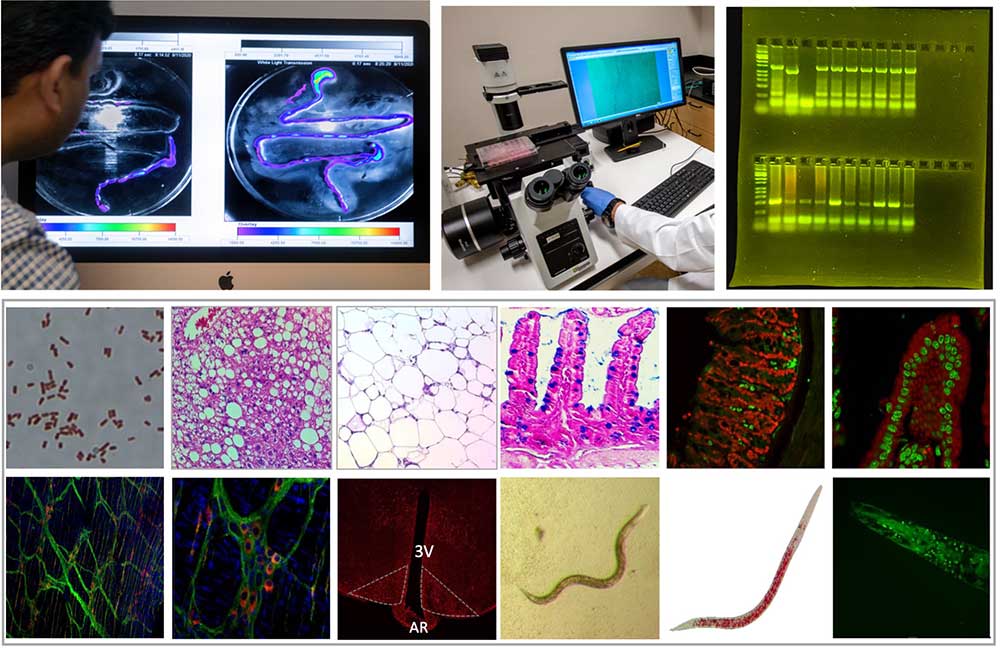USF Microbiome Research
Preclinical Studies

Food as Medicine
Our preclinical research program is centered around how the gut microbiome, leaky gut influences inflammation which in turn impacts brain health. We are specialized in translating discoveries from bench (microbiology cultures, cells, and organoid cultures, C. elegans, and transgenic animals) to bedside (clinical studies) and vice-versa. We are highly thankful for the support from funding agencies like the National Institutes of Health, Department of Defense, and Florida Department of Health.
Current Projects
- Microbiome and its metabolites in aging-related leaky gut and inflammation
- Development of personalized probiotics, prebiotics, synbiotics, and postbiotics to ameliorate leaky gut and inflammation, and improve brain health
- Cellular mechanisms like gut hormones (GLP-1) and mucin in the gut-brain axis
- Role of free fatty acid receptor 2 and 3 (FFAR2/3) and Gi-signaling in the gut-brain axis
- Repurposing drugs to ameliorate aging-related disorders
-
Upon several years of experience working with clinical studies and knowing the ease and feasibilities of microbiome sample collection to enhance participation and retention, we have organized a customizable and easy-to-handle microbiome sample collection kit (Figure 2). This kit made of a customized printed corrugated box which contains (left in Figure 2): saliva collection tube and its instructions, a pair of gloves, flushable toilet sheets, sample collection tubes with an attached spoon cap filled with a stabilizer solution along with a pre-paid postal small, corrugated box (right in Figure 2). Participants will collect the kit from study sites and will collect samples (both saliva and stools) on the same day at home and will put both -saliva and stool tubes in a pre-paid postal labelled small box that will ship overnight to the Microbiome core. Each kit has a unique ID that can be traced back to the center and participant ID. This kit allows for easy, private sample collection for patients which increases participation and compliance, along with ease of shipping directly to a single center, instead of returning to six different locations.
-
We are well equipped to receive the samples that are shipped from patients/participants' homes. Upon arrival, samples are logged in using their center-specific ID and aliquoted into 5 pre-labeled cryovials and transferred to -80°C freezers. We have an established pipeline (as indicated in Figure 3) and written protocols in place. Two aliquots will remain in the USF Center for Microbiome Research (HeartShare Microbiome Core) further microbiome and metabolomics analyses, while the remaining three tubes will be shipped in batches to the Laboratory for Clinical Biochemistry Research (LCBR, Dr. Russell Tracy, director) at the University of Vermont for long-term storage.
-
The USF Center for Microbiome Research is well equipped with a whole pipeline of microbiome DNA isolation, its quality check, quantification, semi-automatic DNA library preparation and sequencing. It has a dedicated clean chamber for DNA preparations (MyStaire Clean Prep Chamber), Nanodrop for DNA quantity and quality check; Qubit for DNA and library quantification; AB Biosystems Semi-autopipette system for library preparation and Illumina NextSeq1000 sequencer (Figure 4). This setup gives us an opportunity to process our samples in-house with high-quality data generation in an economic way, as well as optimized data to feed in our bioinformatics pipelines for rigorous and robust analyses.
-
We have following bioinformatics pipelines for microbiome analyses:
- 16s rRNA microbiome analysis pipeline: For bacteria-specific analyses uses the 16S rRNA approach sequencing. This process involves PCR amplification of 16S rRNA using specific primers, and preparation of libraries, which in turn are sequenced using Illumina sequencer. The data files are generated as Fastq files, which run through a quality and adapter trimming process. Then, using QIIME2 and/or DADA2 pipelines we determine OUT clustering and phylogenetic bacterial abundance as well as alpha and beta-diversity indices. The output files of QIIME2 (biome files) run through the PicRust pipeline which predicts the functional metabolic function of the microbiome and its relationship with host health. We routinely run these analyses for our studies of the mouse, monkey, and human microbiome analyses, using our well-published protocols.
- Shotgun metagenomics analysis pipeline: Using our Illumina NextSeq1000 sequencer we have optimized the sequencing and bioinformatics pipelines for analyzing microbiome in mouse and human samples (stools, saliva, and urine). We prepare DNA and libraries which get sequenced using NextSeq1000 in our core and generate Fastq files with raw data. We run these Fastq files with quality check and adapter trimming, followed by Metaphlan3 to calculate alpha and beta-diversity indices, phylogenetic Bacteria, Viruses, Archea, and Fungi abundance. Further, we also run the outcomes of Metaphlan3 through the Humaan3 pipeline to determine the microbial metabolic pathways to predict the metabolic function of the microbiomes and their relationship with host health. These analyses will determine how the microbiome (bacteria, viruses, Archea, and fungi abundance) differs in HFpEF patients compared to controls, and whether and how microbial metabolic pathways are linked with HFpEF pathology.
- Biomarker discovery tools: We are also prepared to analyze the microbiome data for their potential as biomarkers using tools like Linear discriminant analysis Effect Size (LefSe). The functional characteristics of microbiome (i.e. inflammatory, pathogenic and antibiotic resistance) will be assessed using BugBase pipeline analyses. These analyses will allow us to determine whether microbiome signatures hold biomarker capacity to differentiate/predict HFpEF pathology, or play a causal in HFpEF pathology
-
We use the Illumina Base Space cloud server for accessing the raw microbiome data like Fastq files. For further analyses like QIIME2, DADA2, Metaphlan3, and Humaan3 we use our high-capacity computer system to run these pipelines in Linux mode, and export data in excel or csv formats for further plotting using r scripts. All these files are also stored in secure and IRB-approved cloud-based Box folders. The individual subject data in excel/csv format is also uploaded to the RedCap system with other metadata. RedCap system allows us to share this data in a secure and faster manner. We will use this same pipeline of data generation, management, and sharing system for the HeartShare study with the Data Translation Center.